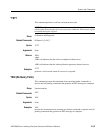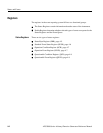
Status and Events
AFG3000 Series Arbitrary/Function Generators Reference Manual 4-5
Status Byte Register (SBR). The SBR is made up of 8 bits. Bits 4, 5 and 6 are
defined in accordance with IEEE Std 488.2-1992 (see Figure 4-2). These bits are
used to monitor the output queue, SESR, and service requests, respectively.
Figure 4-2: The Status Byte Register (SBR)
Table 4-1: SBR bit functions
Bit Function
7 (MSB) OSB Operation Status Bit. Indicates that an operation event has occurred.
6 RQS Request Service. When the instrument is accessed using the GPIB
serial poll command, this bit is called the Request Service (RQS) bit
and indicates to the controller that a service request has occurred (in
other words, that the GPIB bus SRQ line is LOW). The RQS bit is
cleared when serial poll ends.
6 MSS Master Status Summary. When the instrument is accessed using the
*STB? query, this bit is called the Master Status Summary (MSS) bit
and indicates that the instrument has issued a service request for one
or more reasons. The MSS bit is never cleared to 0 by the *STB?
query.
5 ESB Event Status Bit. This bit indicates whether or not a new event has
occurred after the previous Standard Event Status Register (SESR)
has been cleared or after an event readout has been performed.
4 MAV Message Available Bit. This bit indicates that a message has been
placed in the output queue and can be retrieved.
3 QSB Questionable Status Bit.
2 EQS Error/Event Queue Summary.
1-0 ––––– Not used
RQS
RQS
ESB
ESB
MAV
MAV
— —
MSS
MSS
7
6
543210
5 4 3 2 1 0
6
OSB
OSB
QSB
QSB
EQS
EQS


















